On Tuesday, May 25, 2011, we leave the Caravan Park at Kareekloof for the last time ..... hopefully ......
After getting some supplies for the next service from Cummins and a last good-bye to Piet and Pam Kleynhans we leave the Johannesburg area and head west.
The weather looks as if a cold front is coming in from the east.
Apparently it has started snowing in Lesotho last night ..... luckily it did not happen a few days earlier when we were there .....
We travel south-west to Wolmaransstad on the N12.
The OKA feels very good and stable.
The slight shake we have had for a while is gone and the traction is excellent.
For the first time since we have the OKA Susi trusts the axles; for her the trip around the world starts now.
Let's hope she is right!
By lunchtime the temperature has risen to just 13°C and a cold wind is blowing.
We turn west and travel towards Schweizer-Reneke on the R504.
It does not take long and the potholes (and mine trucks .....) start again.
At least somebody has taken his time and filled the worst ones in with dirt!
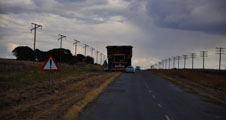
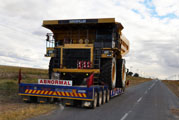
Even a huge mine truck is transported on this narrow road!
The R34 to Vryburg is only better with respect to the portholes.
The sides of the road are ruined with large junks of bitumen broken off making the crossing of trucks a bit of a challenge.
Then we reach the border of the district of Vryburg, the road widens and is well maintained.
Thanks for that.
By now the temperature has dropped to 10°C and patchy rain sets in.
Luckily we did not get this rain on the narrow road!
We want to get as far as possible and decide to aim for Kuruman.
Even though we get through a section of construction sites pretty quickly the night closes in on us too early for our taste.
The N14 is still just a two-lane bitumen road and has a lot of mining trucks on it.
At night this is no pleasure at all but we make it to Kuruman and find a spot in the local caravan park.
On Thursday morning we continue on westwards past large iron ore mines, long trains ...... and construction sites ........
Things are moving, roads are being built / widened ..... but there are still many roads to be done!
Outside of Upington a police officer stops and deviates us into a weight bridge station.
A few trucks are already parked on the other side of the weight bridge. Well, this could get interesting .....
We enter just behind a sheep transporter and watch what they do.
Then it is our turn.
The lady asks us to put the first axle on the scale then the second one and then she say "Thank you".
Not knowing what to do next we follow the sheep transporter which heads out of the station and back on the road again.
So we do the same ...... as nobody yells and screams and no police car follows us it is probably correct ......
In Upington we get the service done.
Upington is a great little town where you can get almost everything.
But we cannot get Namibian currency.
Even though they are more or less a border town the banks here only stock it if somebody happened to come back from Namibia and exchanges it for Rand.
And even then they only stock it for a few days ...... but apparently we can get it at the border.
We will see.
This is the first time we really change countries in Africa (Lesotho was not really outside of South Africa, they accepted Rand everywhere) so we have to find out how things are done here.
Then it is time to settle down at the caravan park and update our travel registration on the web-pages of the Australian and Swiss Government regarding our change of country, load the correct maps onto the GPS etc. etc. etc.
As the night is a cold one with –0.5°C in the morning we decide to try out the repaired heater to preheat the engine.
Will it start at all????
After blowing a huge amount of smoke and fumes it really kicks in and nicely does its job.
Yeah!
We leave Upington and head north.
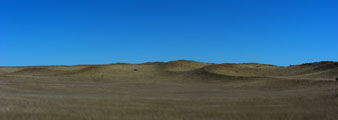
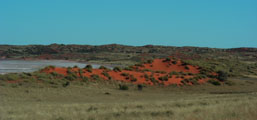
Soon the country becomes undulant with overgrown dunes, yellow grass and red sand ......

........ could well be somewhere in Australia!
Just the road kill is different, no kangaroos but foxes, jackals, other furry things ......
We reach the border control and get the paperwork done.
It is our last day of the visa and the officer explains to us why we did not get a visa on re-entry from Lesotho.
So we know for the next time that we have to be out of the country for longer than just 2 days otherwise they will only give a 7-day visa and only the Department of Home Affairs can extend it.
But if we come back to South Africa after having travelled a while in other countries then we would have no problem getting another 3-month visa. Good to know, just in case we have to ship the OKA out from Durban again because we cannot travel through any of the northern countries.
Next the police have to stamp our Carnet and they also inspect the OKA and let it "pass" the border (= open the boom-gate and let it drive to the parking on the other side of the fence).
Then we settle down at the camp in Twee Rivieren and have an easy afternoon with some PC work.
One thing is good: The maps and the Lonely Planet Guide were wrong!
a) the road is all bitumen up to the border
b) there is mobile reception
In the evening we invite the Belgian couple that Ruedi had met on the camping ground in Upington.
They only have a tent so we invite them to the warmth of the OKA for the evening.
On Saturday morning it is only 12.5°C in the cabin so Ruedi wants to turn on the heater ..... but it only produces a lot of smoke and does not start.
What a shame ......
Now that we are legally out of South Africa (even though we are still on South African soil) we can finish the work we wanted to do in Johannesburg but had not time left for it.
Ruedi gets busy with repairs: The food vacuum machine and the mixer have to be fixed and the fan has to be installed above the glass ceramic plate as it now will be our heater.
Then the finishes the axles and installs axle breathers.
Susi works on the web page.
All day we get visitors who are interested in knowing where we come from.
We are a bit exotic ......

For dinner we have an original Emmi Cheese Fondue .... in the frying pan on the electrical cooker ..... but it tastes great.
Then the sun sets and we quickly move into the OKA.
Sunday is spent with preparing the coming visit of Ruedi's Godchild Simon and some web work.
On Monday we go for a Game Drive along the Auob River.
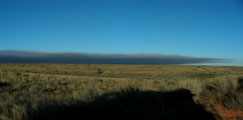
The sky looks like a storm is brewing.
It does not take long and the front reaches us; we even get e few drops of rain!
Luckily the wind that came with the storm dies down quickly and we are very lucky with animal spotting.
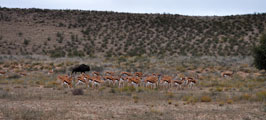
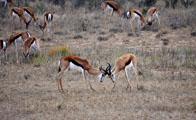
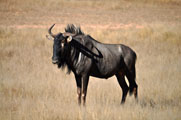
Then we stop at one of the waterholes to watch some Springboks and Gnus.
The young males are exercising their fighting skills.
Click here  to view the movie. to view the movie.
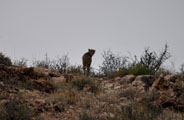
When checking the surrounding hills with the binoculars we also spot a Cheetah on top of the dune watching the waterhole.
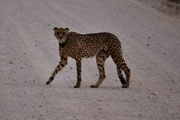
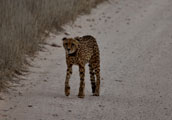
Just a bit further down the track a Cheetah comes walking through the grass and crosses the road right in front of the OKA!
This is just too good to be true!
Click here  to view the movie. to view the movie.
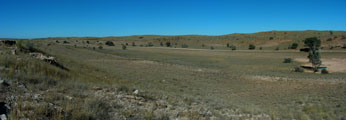
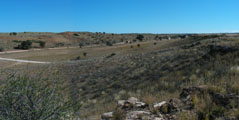
We stop at the Auchterlonie Museum for Breakfast.
We wonder how people did manage to survive out here.
This year there is plenty of feed after the good rains they had, but normally this place must be dry, windy and very hot.
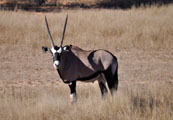
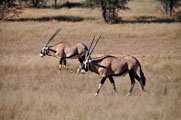
We come past some nice Oryx. They look very elegant with their large horns.
Apparently the points of the horns are so strong that the local San people use them for hunting.
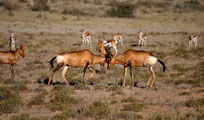
Some Red Hartebeests also try their skills in fighting.
Spring must be close ......
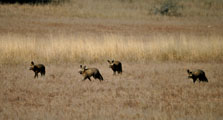
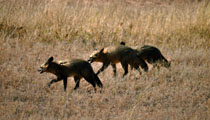
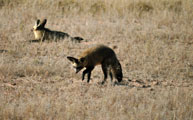
Then we spot a group of Bat-eared foxes.
They look funny with their large ears.
Click here  for the movie. for the movie.
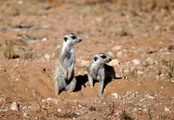
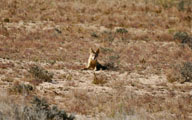
Next we spot some Meerkats or Suricate as they also call them.
They stand very still and look in one direction .... as if they are very alert and watching something ...... or somebody .....?
We look too but only after a while .... and probably because it was moving ... we spot a Black-backed Jackal.
No wonder the
Meerkats are so vigilant!
Ruedi tries to distract them but not with much success .....
Click here  to view the movie. to view the movie.
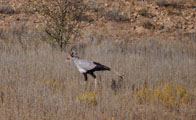
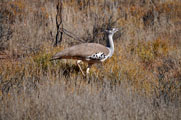
We also spot a Secretary bird with his feathers up and a Kori Bustard comes really close.
Full of impressions we head back to the camp.
What a day!
On
Tuesday we have to relocate to Nossob Camp which means another Game Drive but this time along the Nossob River.
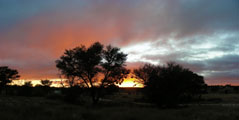
We get up early as it will be a long drive and we don't know what to expect with regard to the gravel road.
Again it is below 0°C and Ruedi does not like it.
It means that the OKA will have to work hard in the sand with a cold engine .... but we cannot help it.
On the way to the Nossob we have to cross some dunes.
The wind is fairly strong and due to this we only start seeing animals in the valley of the dunes.
First we spot some birds and then shortly after a few Black-backed Jackal.
We wonder how far away from the water holes they go for a feed ....
By the time we reach the Nossob River the sun is out and the wind has quietened down.

Soon we start seeing herds of animals .....

... most of them still on the ground to shelter form the cold wind.
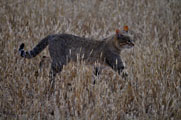
Then we see an animal in the grass walking towards the road.
It is an
African Wildcat and it comes straight for the dead tree in front of us.
We watch and cannot believe what is happening:
The
Wildcat gets in position in front of the tree trunk that is lying on the ground .... the tail is going left .... right .... left .... right .....
Then it jumps into the hole of the tree and we hear noises of a fight.
Then we see something running out of the tree trunk and leaving in a hurry ...... it is a Black-backed Jackal!
So either the Jackal had moved into the
Wildcat's nest or the Wildcat had just scared the Jackal away ... in any case, this is just another very lucky animal sighting for us.
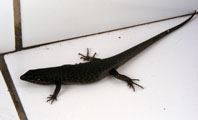
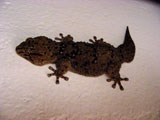
At the picnic area Susi find a lizard in the wash basin.
When she gets all excited about it and gets in position with her camera a gentleman tells her that in the men's toilet there is a Gecko behind the door .....
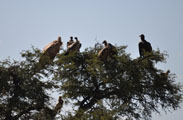
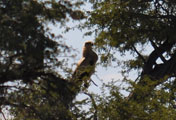
We continue on and see some White-backed Vulture and a Lapped-faced Vulture on a tree.
There must be a kill somewhere close by, but we are not allowed to leave the vehicle .... and besides that, a kill usually means predators .....!
Then we also spot a
raptor waiting in the tree too .... Susi guesses that it is a Steppe Buzzard but she is not sure ....
We come past a water hole and a driver stops us.
He tells us that there is a Leopard
behind the bush.
We try to spot it but just cannot figure out which bush and where ....
We give up and start rolling away slowly .... and then Susi spots it!
The Leopard had just gotten up and started walking toward the water hole.
Quickly Ruedi gets the OKA into reverse and drives back to the water hole where he stops the engine.
Now we have to wait and see if the Leopard still comes for a drink or if we are too close for his comfort.

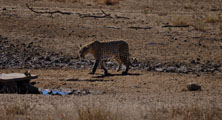
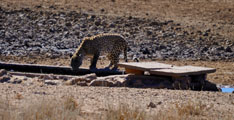
but it does not take long and he comes ..... and takes all the time in the world to get his drink before he slowly walks away again.
What a sighting!!!!!
Click here  to view the movie. to view the movie.
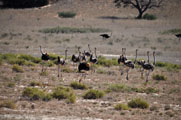
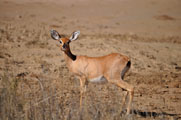
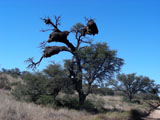
We continue on and see large groups of Ostriches, a Steenbok, a nice example of a Sociable Weavers' nest ..... and by the end of the day we have seen
13 Black-backed Jackals!!!
Our teacher Albie in Karongwe once said that animals are made NOT to be seen out there ..... imagine how many where out there if we spotted 13!
What a day!
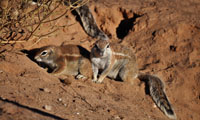
We reach Nossob Camp and enjoy the many Southern African Ground Squirrels that have converted the camp into one big borrow.
Click here  to view the movie. to view the movie.
In the evening we get into the hide and hope for animals to come for a drink.
We heard that last night some people were in the hide and suddenly heard the roar of a lion ... that was actually lying underneath the elevated hide ....
and apparently had left the camp today in direction of the next waterhole.
But we are unlucky, nothing shows up .... it just is veeeery cold and we just don't have the nerve to stay there too long.
I know, I know ..... but somehow we are getting too old (or less enthusiastic? or too spoiled by the things we see during the day ....???) for things like freezing our bums off to see animals come for a drink .... sorry ....
On Wednesday, June 1, no drops from the roof hatch wake up Ruedi ...... they are all frozen .... the temperature outside reads –4.5°C ......
We leave Nossob Camp as soon as they open the gate at 7:30 AM and head straight south along the dry Nossob River to the Marie Se Gat waterhole to see if the lion is still there.
Fresh large cat footprints indicate that it has been here ......
Then we see the cars and people point over to the other side of the valley.
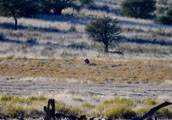
The lion, a large male, is there but if is far away and we would not have spotted it without the directions given by the other tourists.
As today there is no wind the animals are out in force, but "only" animals that we have already seen.
We turn off towards Mata-Mata and the landscape changes and becomes less vegetated and dryer.
Up here in the dunes we can only spot a few Oryx and Ostriches.
But as soon as we reach the dry Auob River again the animals are back.
We head north towards Mata-Mata.
When we turn off towards the Dertiende Boorgat waterhole Susi spots some large cats footprints again.
This time it must be more than one cat ...... then we see the cars and some lions.
We spot two but are corrected by another tourist that it is a pack of five!
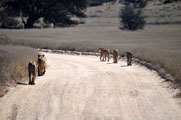
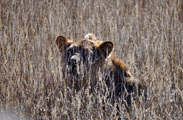
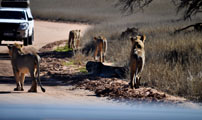
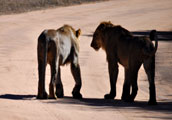
We follow them as they leisurely walk on the gravel road.
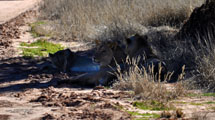
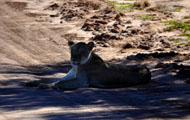
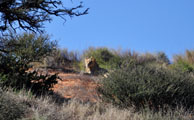
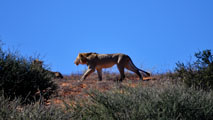
Then they lay down under a tree and all cars stop.
For a long time we can watch them.
What a sighting!
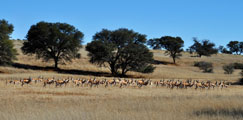
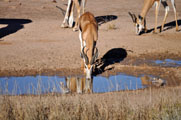
Close by is a large group of Springboks but they are not worried about the lions at all.
Amazing!
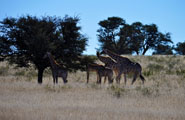
At the next waterhole we spot some Giraffes.
On the way north we see some more bat-eared foxes and black backed Jackals.
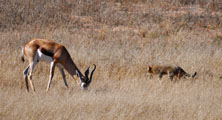
Then just shortly before Mata-Mata we see another African Wildcat.
It walks past a
Springbok and to our amazement the Springbok does not even stop eating.
Obviously Springbok is not on the menu card of an African Wildcat .....
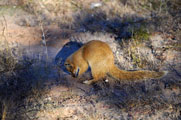
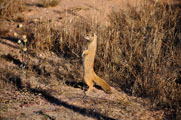
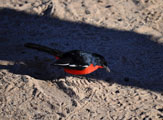
We reach Mata-Mata and settle down in the camp.
Soon Susi is busy having a look at the "locals".
A Yellow Mongoose is busily looking for dinner.
Click here  to view the movie. to view the movie.
What a day!
We had been warned that in Mata-Mata the temperature drops even further during the night so in the evening we insulate the roof hatches .... and not in vain!
On Thursday morning we wake up to -5.5°C ...... and ice in the roof hatches again. We still use the diesel stove and the fan as heater. The diesel heater for the floor heating is still broken and we have not a clue if we are able to repair it here in Africa at all.
The insulation of the roof hatches increases the temperature difference between the outside and the cabin by additional 4°C to about 20°C. So it is worth the effort.
What does not like the cold temperatures is the engine.
It coughs a bit ...... probably its way of complaining and requesting that the heater is fixed and it gets its pre-heating on cold mornings like this ........
We cross the border to Namibia and are a bit surprised that nobody wants to stamp our Carnet.
The people at the border post say that they don't have customs here and if we want a stamp we should try again in Keetmanshoop, the administrative town for this region.
We don't mind. If they don't stamp the Carnet
at the entry we don't have to worry getting an exit stamp when we leave the country.
The gravel road is excellent and soon we reach our turn-off. We want to travel on the D503 through the dunes.
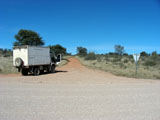
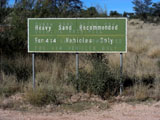
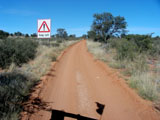
The track looks interesting and we wonder what the "Keep left" sign is supposed to be for on a single lane sand track ......
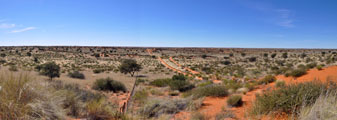
But then the truck doubles and now all makes sense.
They have one lane for each direction, a clever way to avoid head on collisions over the dunes.
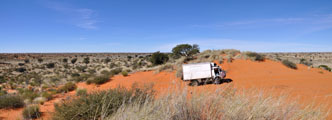
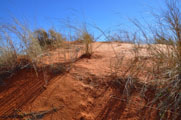
The colours are like in Australia.
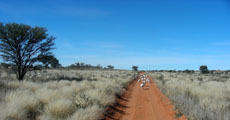
The sheep are a bit a pain.
They are scared of vehicles and run away. But the fastest place to run is the track!
We try everything.
If we drive slowly they just run ahead of us for ever and a day.
If we drive faster they almost kill themselves running ahead of the OKA.
If we drive even faster, beep the horn and almost drive over them they eventually jump away to the sides ...... but careful, they might jump right back onto the road.
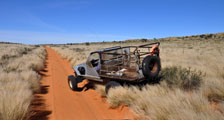
We cross dune after a dune.
Then we are passed by a "farm vehicle" ..... a pretty unusual thing!

One of the first things that come to our attention when comparing South African and Namibian roads is that the road signs are extremely well done. Even out on the D503 every gate has its own warning sign, each sharp curve is marked.
Looks like this part of their German past has remained .....
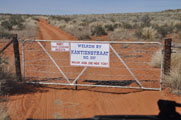
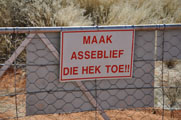
The gates are all marked in Afrikaans and we can only guess what it means .... but as well-trained Aussies we leave them as we find them ...
Note:
Maak assbeblief die hek toe!! = (German) Mach bitte die Hecke zu = (English) Please shut the gate.

Then, just when the GPS tells us that the road will become a minor one, the track widens and becomes an excellent gravel road.
Probably the road was upgraded to cart the cattle out on trucks.
Then we reach the end of the dunes and head north-west to Koes on the C11.
Again it is a well maintained gravel road.
We have to get used good roads again .... no corrugation, no potholes, just smooth travelling ..... nice!
As we get closer to Koes we see a separate trail along the gravel road.
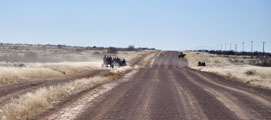
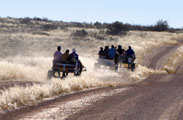
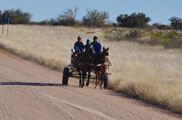
Soon we also find out what it is for: For donkey and wagon!
This seems to be a common form of transport out here.
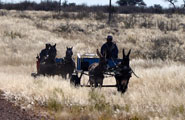
There even seem to be "taxis" .....
In Koes we try to find an ATM but have not much success.
The corner store that has an ATM is either closed or broken and the service station has no ATM.
The whole place is deserted ..... could it be that it is a public holiday?
So we continue on south-west on the C17, another excellent gravel road.
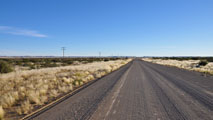
The country is flat.
Only at the horizon in southerly direction we can see mountains, probably the Groot Karasberge.
The ground is covered in yellow grass; in Australia it would most probably be Buffalo Grass.
There is almost no traffic. Besides the odd donkey wagon we see maybe a handful of vehicles all day ........ next to nothing ......
Then quite suddenly the country changes.
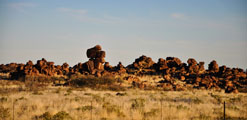
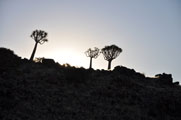

Piles of rocks lay around and quiver trees appear.
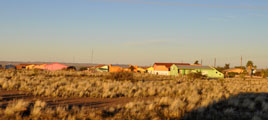
We pass small townships with colourful houses.
We continue on to Keepmanshoop.
Here too the town is deserted ......
We check in at the municipal Campground ..... we are the only guests ......
The guide book says that this is one of the best municipal campgrounds in Namibia.
Well, either the guide book is a fair bit out of date or we better don't expect too much from municipal campgrounds...... there is no toilet paper in the toilets, the ladies shower has no hot water and Susi has to use the men's side, all is a bit run down and needs a good face-lift ..... but it is clean ..... and the water is hot in the men's section and there is plenty of it too.
The night stays very comfortable "warm" with 7.5°C ABOVE ZERO!!!
Nice change.
On Friday morning we adjust the time to Namibian time by advancing the clock by one hour.
Then we find out that yesterday actually was a holiday ..... Ascension Day ...... no wonder all was closed!
We head into Keepmanshoop and get organised by finding out the speed limits in Namibia, getting a SIM card, airtime and a data pack to access the internet, some shopping and we try to get liability insurance for the OKA .....
Namibia like South Africa has some insurance included in their fuel price but nobody can tell us what's included and if it is also valid for tourists. It is very confusing.
So we might have to do it like we did in South Africa and just drive around without insurance. We don't like it, but what can you do?
Then we leave the town and head south west on the B4.
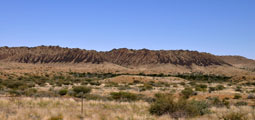

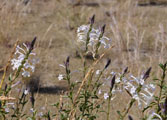

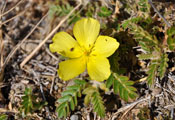
We come past some interesting mountains and Susi finds some flowers.
After the recent rains she might be lucky and get her flowers after all .....?

Then we turn south on the D545 past the Naute Dam that dams the Löwe River.
Note to the reader:
"Löwe" means Lion in German and what looks so peaceful apparently can bring quite some water.
Just a few weeks back there was so much water in the river and dam that they had to open the flood gates.
The water flooded the Fish River Canyon and a group of German tourists was lucky to escape from an island in the river and they had to be rescued.
Luckily we picked that route!
Had we picked the C12 to drive south we would have found a "Road closes" sign and would have had to back track all the way.
We had wondered about all the oncoming traffic including some rather large trucks on that small dirt road .....

Then we travel along the pretty Klein Karasberge.
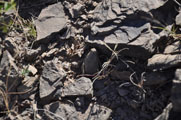
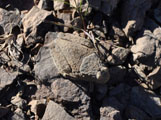
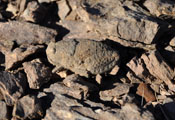
Susi finds this amazing little hopping insect that just blends in perfectly.
We continue on the C12 and then deviate toward the Fish River Canyon.

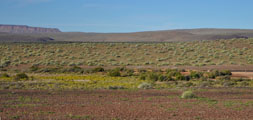
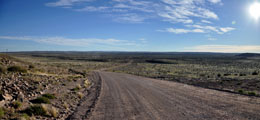
On the way towards the camp we see Gemsboks (Oryx Antelopes), Harman's Zebras, Springboks and Kudus.
We wonder how they can survive in this arid area.
After the unusual heavy recent rains there is plenty of grass but normally it looks bit different ......
We find a spot in the Hobas Camp and settle down.
On Saturday, June 4, we go for a drive along the Fish River Canyon.

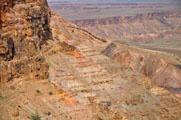
It is a very impressive canyon with some very pretty vistas.
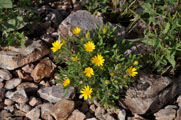
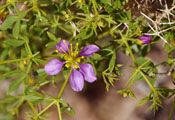
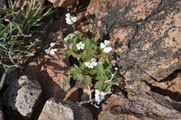
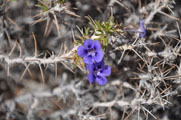
Also there are many flowers blooming.
One of the tour operators we chat to tells us that due to the good rains they have had recently they see flowers that they haven't seen for years.
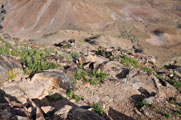
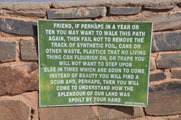
The Fish River Hike starts here, a 4 - 5 day walk from Hobas to Ai-Ais.
One has to make a reservation well in advance to be able to do the hike. It is tough (medical certificate required) but apparently its worthwhile.
We drive from one lookout to the next one .....

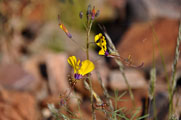
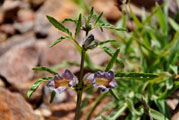
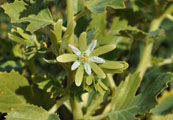
Each has pretty views .... and of course flowers for Susi .....
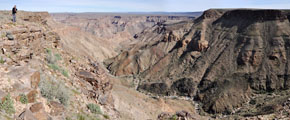
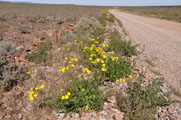
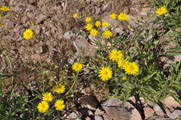
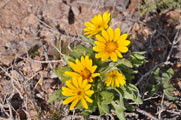
The best vantage points can only be reached on a 4WD track.
This is great because it keeps the majority of the tourists and especially the tour operators away.
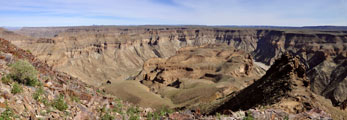
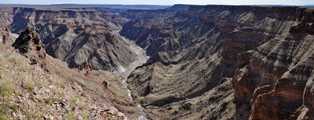
It is amazing how the Fish River has carved these canyons.
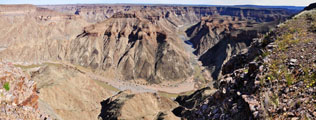
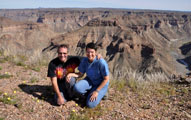
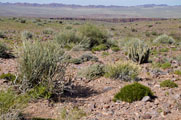
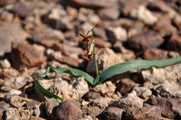
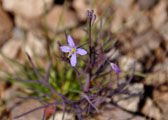
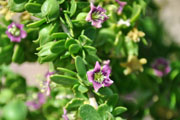
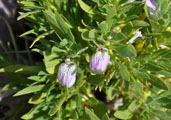
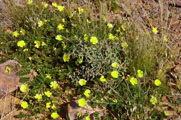
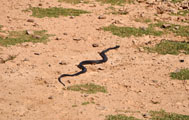
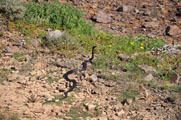
We also disturb this black snake ..... no idea what it could be .....
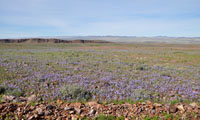
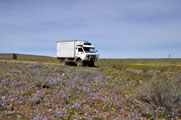
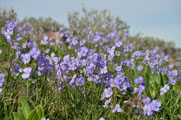
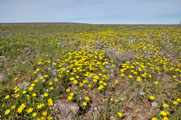
Then we reach a particularly nice area ...... amazing!
And this in the middle of the desert!

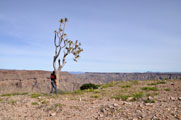
The quiver tree at the verge of this great view point is quite high.
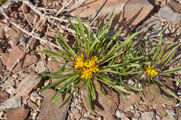
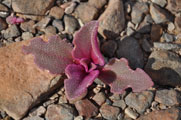

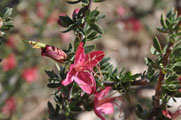
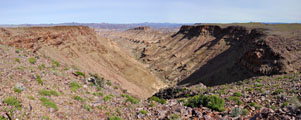
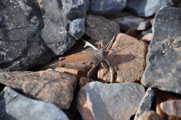
There is not just great views, there are also interesting little creatures living amongst the rocks ....
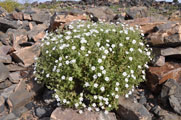
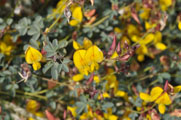

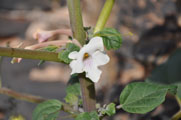
Each spot has its own selection of flowers .....

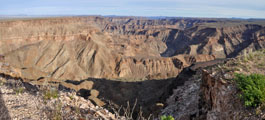
Ruedi has seen the Grand Canyon but he reckons that the Fish River canyon is as pretty as its larger brother and he likes the Fish River Canyon better because one does not get lost in his size ....
Bigger doesn't necessarily also mean better.


This view point has some succulents and on one of them Susi finds an Armoured Bush Cricket.
They are everywhere and
apparently are a real pest .... but they look great.
Tired and full of very pretty images we return to the camp.
On Sunday morning we head south through some very pretty mountains to the Ai-Ais Resort in the Ai-Ais National Park.
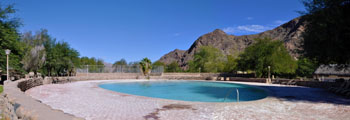
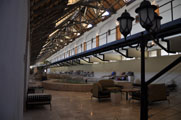

It is definitively not what we expected ...... it is very pretty, stylish, has an indoor pool, an outdoor pool, some thermal pools, powered sites, a kiosk, a shop, a pretty restaurant, etc etc. ..... and all for just 125 N$ (about 18 AUD) per night!
We book for three nights and settle down.
On Monday morning we leave early for a hike along the river. We hope to get near the towering canyon walls.
There are a few clouds around but otherwise the day looks promising.
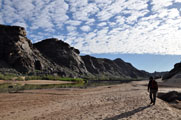
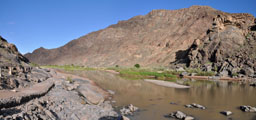
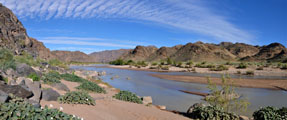
There is no real track and one has to find the route on its own along the river bed.
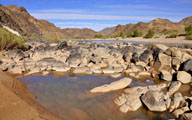
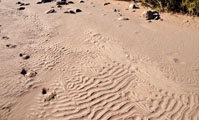
It is obvious that the water has been much higher in recent weeks.
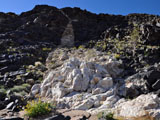
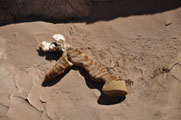
There is a lot to see along the way .....

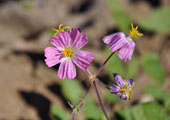
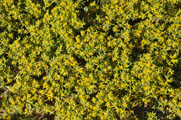
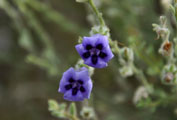
... and flowers for Susi .......
After some 5 km we figure out that we will not reach the high walls of the canyon.
So after a bit of studying the map on the GPS we decide not to follow the river any further but to get on top of the mountains.
And that decision turns out to be perfect.
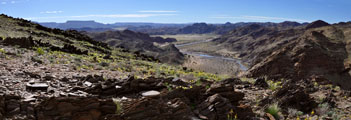
Already on the way up we can catch a glimpse of the valley carved by the river.
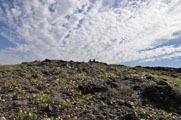
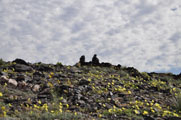
Then we reach the top and decide that this is the spot for lunch .....

Just look at the views!
Just imagine:
By the time the hikers reach this bend in the river bed they have been on their feet for 4 - 5 days ...... sand, rock-hopping, river crossings ..... and all with full gear ... maybe 20 - 25 kg in the backpack ...... this is definitively not for Sissies!
We feel sorry for the poor hikers.
(Later on we meet some hiker that just have finished the hike and they confirm that the last few km are the worst of the whole trip).
During lunch the wind changes the direction and it gets cold.
Also some clouds start appearing and we decide to head back before we get some rain.
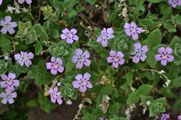
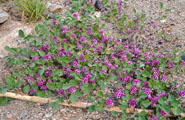
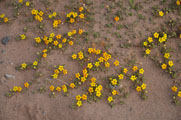
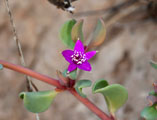
It is a long way back but Susi still finds time for her beloved flowers.
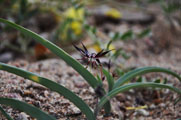
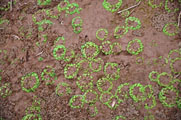
Some of them are really interesting .....
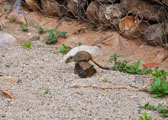
Just outside of the camp we spot this Dassie Rat.
Tuesday and Wednesday are spent in front of the PCs ...... and in the indoor thermal pool ......
A cool wind keeps the day temperatures around the 17 °C mark and every so often a few rain drops fall.
On Thursday morning the weather looks good again.
We leave Ai-Ais and head west to the crossing with the C37 and there we head south.
Right at the gate of the Aussenkehr Nature Reserve the small track of the Gamchab 4WD trail leaves to the west.
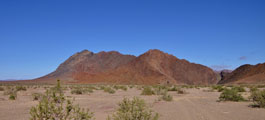
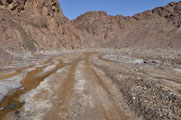
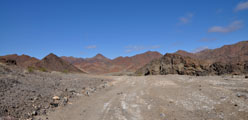
The track leads through the mountains and is very pretty.
As we are driving it north to south we have the perfect light.

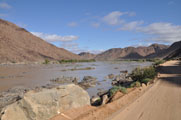
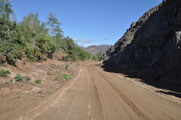
We reach the C13 and follow the Orange / Gariep River to the west.
The gravel road obviously has been graded recently.
Later on we see sections where the recent rains must have washed away the road; all is brand new and there is no corrugation at all.
When we reach the mark for a "Halfmen Tree" (Pachypodium Namaquanum known as elephant trunk - a succulent only existing in Namibia) on Tracks4Africa we search in wain.
But some 500 m later on we see piles of rocks on the side of the road indicating that there is something to be seen.
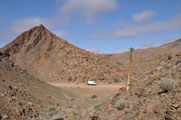
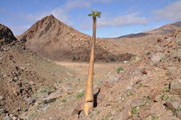
And here we find them.
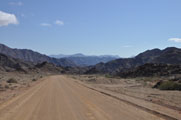
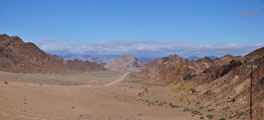
We continue on from one pretty sight to the next one.
It is a very nice track to drive.
When we reach the end of the track we are stopped by the Border Police but they are happy with our fake Australian Drivers Licenses and let us continue with our journey.
We stop at the mining town of Rosh Pinah to enjoy the luxury of fresh milk from their well-stocked SPAR.
At Rosh Pinah the bitumen starts again.
The road climbs and climbs and climbs ...... not steep but steady ........ from approx. 500 m to 1200 m above sea level.
We are actually driving up the slope of a huge sand dune.
The country changes from bone dry to green. Probably the humidity from the Orange / Gariep River condensate here and gives the plants plenty of humidity.
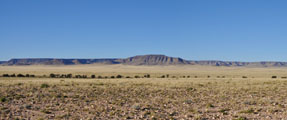
The tableland we reach is covered in yellow grass that shines golden in the late afternoon sun.
Then we reach Aus and the B4 west to Lüderitz.
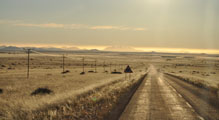
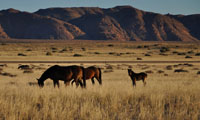
Some 20 km outside of Aus is the Wild Horse Waterhole.
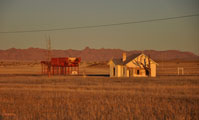
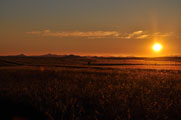
Right after he abandoned Garub train station we find ourselves a spot behind the railroad track for the night.
It is not easy to "disappear" out here where all is flat and there are no trees ......
On Friday, June 10, we continue on towards Lüderitz.
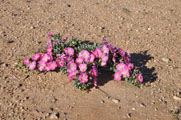
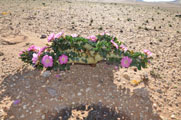
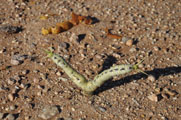
We come past some blooming succulents.
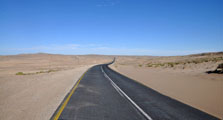
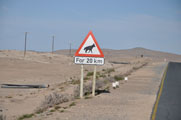
The country changes to sandy desert.
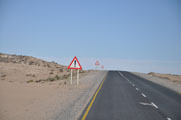
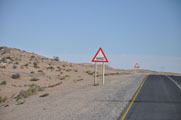
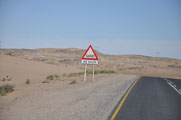
The road signs are typical for Namibia:
Caution! Wind! Sand!

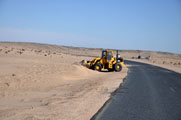
Just before Lüderitz there are drifting sand dunes and they are cleaning the sand from the bitumen.
We hear that there are days where the wind is so strong that they have to close the road because they cannot remove the sand quickly enough.
Under those conditions it can happen that a dune moves up to 18 m in one day!
In Lüderitz we head out to the Shark Island Camping which lays on a peninsula.
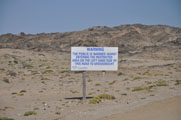

After checking in we go for a drive out to Griffith Bay, right opposite of Lüderitz.
It lead through the Sperrgebiet, a large area that is not accessible for the public for decades because of its diamonds!
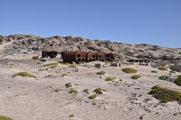
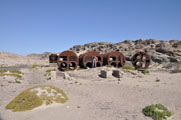
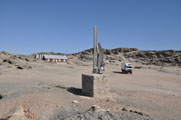
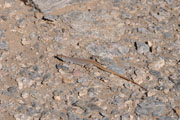
At the Sturmvogel Bucht (Shearwater Bay) we have a closer look at the remains of a whaling station.
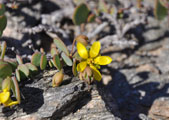
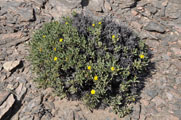
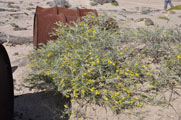
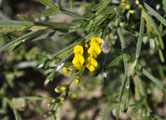
Even out here where there is a lot of salt and sand. The flowers are blooming.
But soon all disappears in fog and we head back to the camp for an afternoon in front of the PCs.
On Saturday morning the weather is not yet very convincing.
But soon the sun starts burning away the clouds and the day develops into a sunny one.
So it is time for a trip to the Lüderitz Peninsula and its attractions.
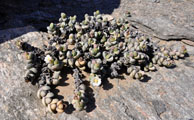
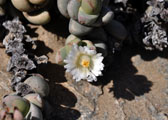
The recent rains have also brought the salt-tolerant plants back to life and to bloom.
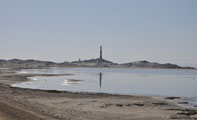
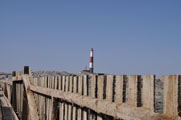
Diaz Point and its lighthouse at is our next stop.
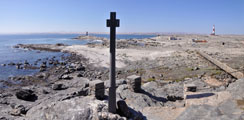
When Batholomeu Dias, one of the first Europeans to visit this part of the world, came here in the 14th century he erected a cross.
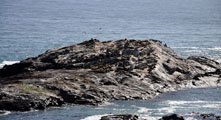
On the nearby island seals are taking it easy.
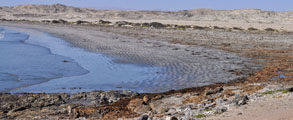

Next stop is Halifax Bay.
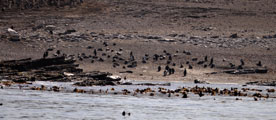
The water is low enough that we can climb out on the rocks and get a good look at the African Penguin colony.
At Klein Bogenfels where the "Bogen" in the "Fels" is so "klein" that we almost miss it .... if it wasn't for a small wall with a braai place we would not have seen it ........

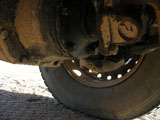
Then we return to Lüderitz via the Grosse Bucht.
The town is deserted, all shops closed ...... well, it is Saturday afternoon after all!
So we head back to the caravan park where Ruedi sees that the yoke of the front diff is losing oil ..... and that after only 2000 km ...... well, even if they are new axles, they were still built by Madara .....
We would be able to fix it ourselves, but due to warranty reasons it means we will have to drive to Windhoek and have it fixed instead of continuing our Namibia tour.
On Sunday morning we visit Kolmanskop.
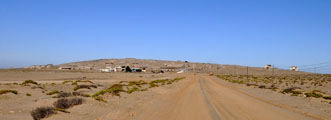
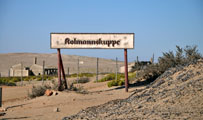
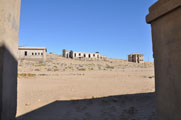
The ghost town (and its helpers) fights against the sand of the dunes but already a few houses have become victims of it.
We have an excellent German-speaking guide and enjoy the tour.
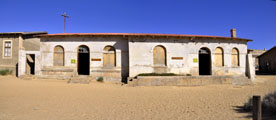
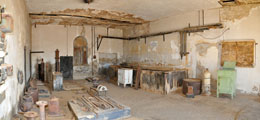
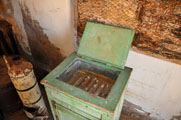
The ice factory was just beside the meat works.
In the ice factory ice blocks were made by expanding ammonia to cool some brine down to -8°C over night.
In the morning the water in the containers would be frozen and the ice blocks ready.
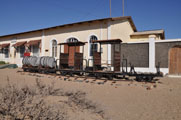
Each house in
Kolmanskop had a fridge and every morning a small train or tram would travel through the whole town and deliver a block of ice per household , 20 lt of drinking water and one fresh "Brötchen" per person to each house ..... and all for free!


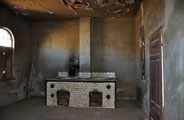
The expanded ammonia was used to cool down the store room of the slaughterhouse.
Sausages were prepared on the large stove.
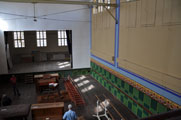
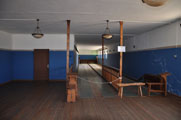
The casino with its festival hall and the bowling alley have been renovated and are still in use.



But most of the town is slowly but surely covered by sand ......


They had a salt water tank which was also used as their swimming pool.
The fresh water would be pumped into tanks past the engineer's house (the only house with trees ......) and stored in tanks on the hill.
![horned adder, horned puff adder, horned viper, Side winding adder [Bitis caudalis]](trip_01/thumbnails/NA_110612_018.jpg)
![horned adder, horned puff adder, horned viper, Side winding adder [Bitis caudalis]](trip_01/thumbnails/NA_110612_019.jpg)
As we inspect the water tank Ruedi spots a Horned Puff Adder or Side Winding Adder.
We had been warned about them as they are very dangerous.
So Susi only takes pictures from a safe distance.
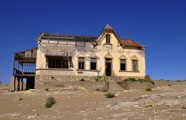
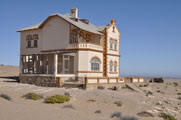
We have a closer look at some of the larger houses.


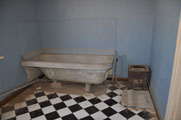
Amazing how fancy they are equipped.
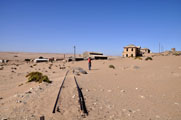

Not much is left of the tram's rails ....
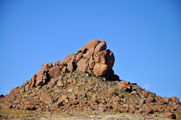
Then we head back to Aus on the C13 and come past their landmark called "The Aus Nose" but we find it to look much more like beaver!
We take the D707 into the pretty Tirasberge.

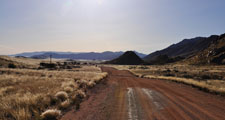
It is already late afternoon the grass looks stunning again.
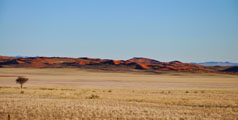
We come past the first few red sand dunes.
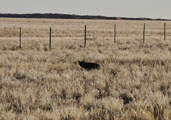
Then we spot a large dog-like animal with black stripes ...... it's an Aardwolf!

A large group of Oryx runs away .....
What a sight!
Then we reach the Natmib Lodge, our target for today ...... but it is closed.
So we camp at their gate.
During the night the temperature drops to 8.5°C but sometime during the night the wind freshens up and the temperature rises drastically.
When we wake up on Monday morning we already have 17°C outside temperature ...... in the shade ......
By the time we leave the camp the thermometer shows 24°C.
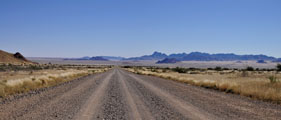

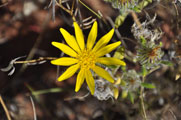
We travel through the pretty valley.
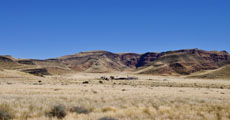
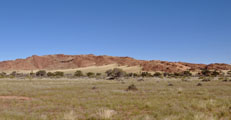
The mountains have deteriorated to some interesting shapes which are emphasized by the grass growing on them.
We also see some good examples of how the wind blows the sand towards the hills and slowly but surely dunes are created.
By 11 AM we see 30°C on the thermometer.
Bliss!
We haven't had temperatures like that for a looooooooooong time. Hack, and we always thought Africa is hot .....
In the early afternoon we reach Sesriem Camp and get the site 28, which is all on its own .....
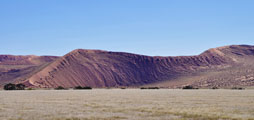
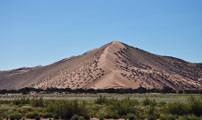
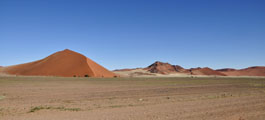
The light is great and the drive to dune 45 gives many chances for pictures.
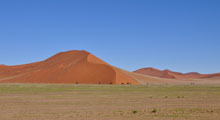
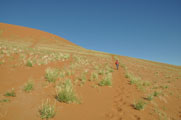
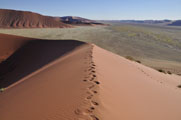
Then we climb dune 45 and enjoy the views.
As we are (still) the only ones here we can also enjoy the quietness.
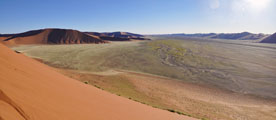
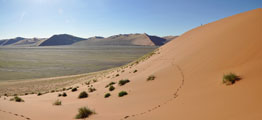
The view towards Sossus Vlei .....

.... the view towards the camp .....
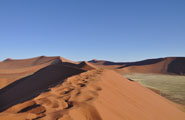
... into the sand dunes .....
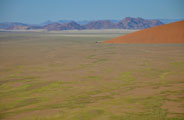
The desert is green and one can clearly see where the water from the recent rains has come through.
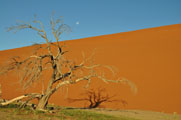
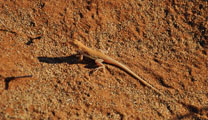
At the bottom of the dune we even find a small "local" ...
Then the tour-operator buses come for the sunset at Dune 45.
We have had our moment and now
it is time for us to leave the place ......
We reach the camp as it gets dark.
A Springbok leaves our camp spot and disappears in the grass, "something" is howling close by ........
Shortly after 5 AM we get up.
A file of vehicles leaves the camp once the gate is opened at 5:30 AM.
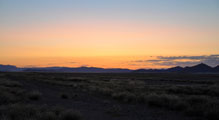
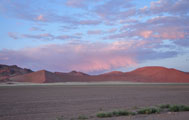
As we drive towards the dunes slowly the day breaks.
There are some clouds about which make the sunrise interesting.
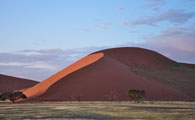
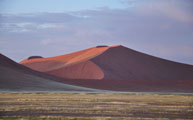
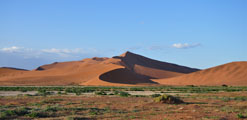
We drive past Dune 45 ... tourists sit on it ..... and head all the way to the end of the bitumen at the Sossus Vlei parking.
There we lower the tyre pressure and have no trouble getting to the dunes on the soft sand.

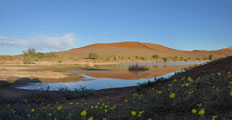
There is still water present at the end of the Tsauchab River.
We consider ourselves very lucky to be able to see this.
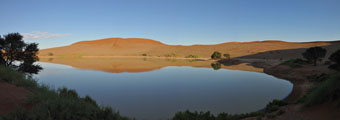
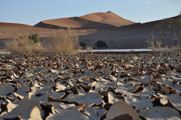
Here the dune blocks the way of river generating the "lake" which eventually will evaporate or disappear into the sand.
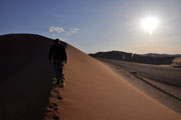
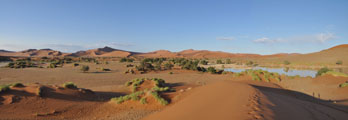
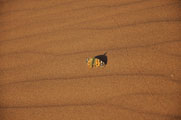
There are not many people here and we can enjoy the peace and quietness.
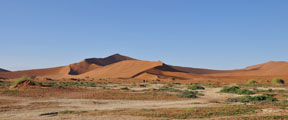
Then we dislocate to the Dead Vlei parking.
More and more cars and people arrive.
Luckily it is still off-season ....

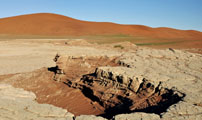
We start the walk over the dunes and reach a dry lake.
It must have had water already a few times and the edge shows some formations.
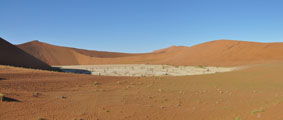
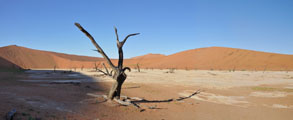
Dead Vlei is dry and looks good with the dead trees.
Some of them apparently have died some 500 years ago .....
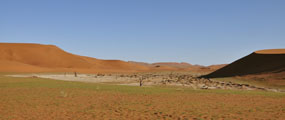
Fresh growth of green plants and the dead trees in the dry lakes ......
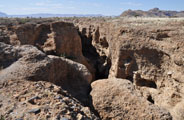

On the way out we visit Sesriem Canyon ..... together with many more people ......
By 11 AM we are out of the park and head north on the C19.
A strong wind has picked up and the temperature quickly rises to 30°C ..... from the 10°C we had during the night.
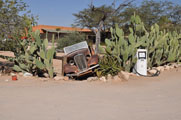
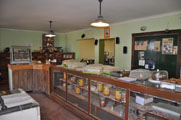
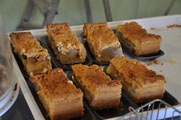
We stop in Solitaire ......... and can confirm that their Apple Crumble is superb ..... and their Strudel if yummy too ......
We are surprised about the amount of cars and people that stop for coffee and cake.
A few kilometres further north we turn east off onto the D1275.
We drive into the valley and then reach the Spreets Hoogte Pass.

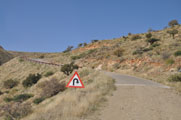
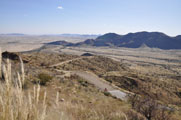
It is very steep and the sign indicating that we should use lower gears has its merits.
But the steepest parts are paved and we can enjoy the great views into the valley.
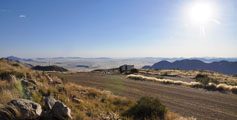
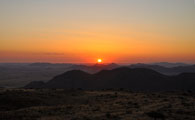
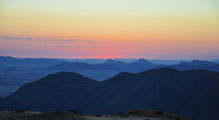
Almost on top of the pass there is a picnic site and we decide to stay there for the night.
It could get windy but so what ...... the OKA will gently rock us to sleep ......
After a spectacular sunset the wind dies down and we have a peaceful night.
On Wednesday we continue on to the top of the pass.
The gravel road crosses little brooks and we are surprised to see water running in this arid area.
The crossings get more and more frequent and we reach an area where the water has been lying on the road for a while but has now dried up.
Next we reach an area where the water has not dried up yet ...... hmmmmmm ......
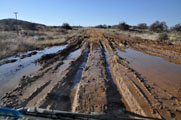
Then we reach a muddy part but get though without a problem.
The next muddy patch is already much larger .....
Ruedi knows that we have lousy tyres for mud and is not really keen on getting stuck.
Luckily all goes well but Ruedi mutters that he rather doesn't want to have to return through this patch of mud ......
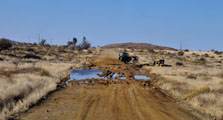
And then we reach the big one ..... the road construction crew is there too ......
One of the men waves Ruedi through.
We haven't much choice than to try it.
Well, at least the right equipment would be there to pull the OKA out of the mud again ..... or worse, to get it back on its feet!
But all goes surprisingly well, the ground is quite hard.
Then the track is in better shape .... freshly fixed by the road crew ......
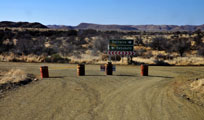
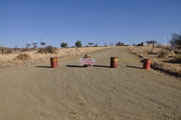
When we reach the end of the D1275 we see that it has been closed .... but only from this side ....
Ahhhhh Africa ...............
We reach a broken down bakkie with some kind of a problem with the carburettor.
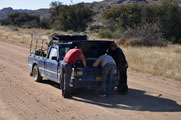
Ruedi assist with a bit of sand paper and they can get it started.
Quickly all climb on board ...... but it does not get far and the motor dies down again.....
As we cannot help any further we continue on and reach Windhoek at lunch time.
Because the guide book says that the Caravan Park has a laundry and Susi needs to wash we check in at the Arebbusch Caravan Park just beside the Eros Airport.
But she is disappointed: the laundry consists of a wash tup where one can do the washing by hand.
The Caravan Park is a bit of a rip-off for what they offer and if you don't have to be in Windhoek south or Eros you might be better off with one of the caravan parks a bit outside of town.
But for us it is convenient and we find a Laundrette nearby and some shopping so Susi's little housewife world is in perfect order again.
And this is it for this journal!
| 
![]() Created by Level X Webdesign
Created by Level X Webdesign